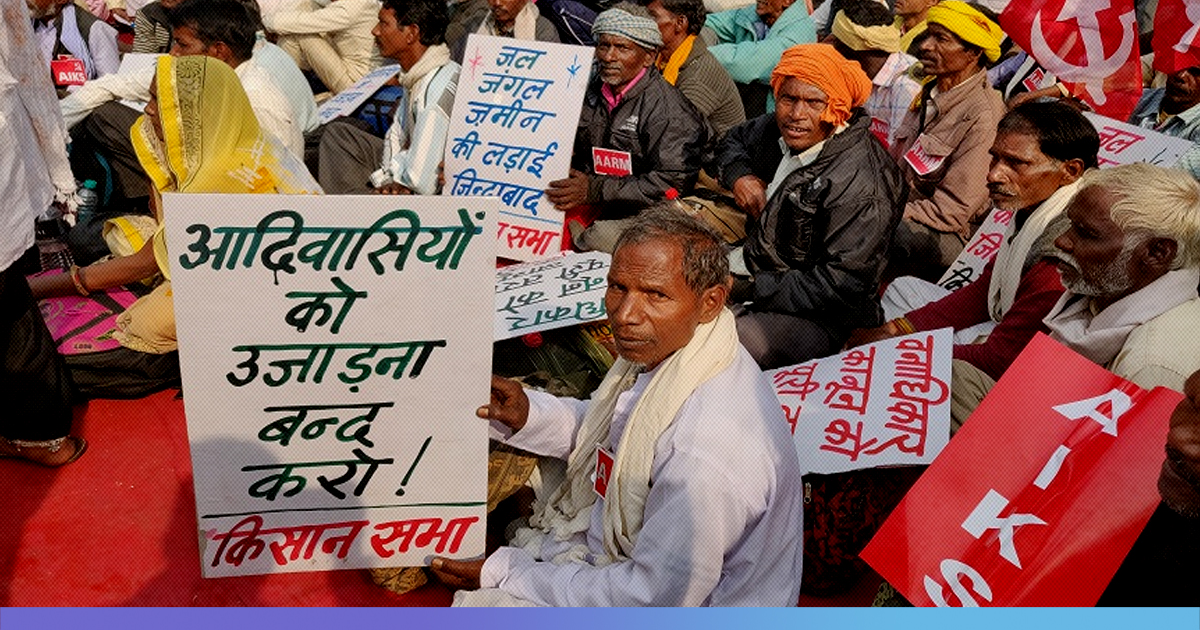Hundreds of Adivasis and forest-dwelling communities from Maharashtra, Madhya Pradesh, Odisha, Jharkhand, Bihar, Uttarakhand, West Bengal and other states are protesting in Delhi’s Jantar Mantar demanding water, forest and land.
The protest is a way of reminding the government to implement the Scheduled Tribes and Other Traditional Forest Dwellers (Recognition of Forest Rights) Act, 2006, also known as the Forest Rights Act, Scroll.in reported.
“Maang wahi hai – Jal, jungle, zameen,” Dasarath, a 60-year-old tribal from Sonbhadra district in Uttar Pradesh said.
The Act recognises Adivasis and other forest dwellers’ rights to live in forests and cultivate forest land up to four hectares. The act prohibits carrying out any activity on the forest land till individual and community claims dependent on it are settled.
The protests are also against the Supreme Court’s February 13 order evicting nearly 10 lakh tribal families across 16 states rejecting their claims to forest land.
On February 28, 2019, the court had stayed the February 13 order and decided to take up the hearing on November 26, 2019. Protestors alleged that forest department officials repeatedly asked them to move out of the forest despite the stay on the earlier order.
“My house is in the jungle, but we are not allowed to collect firewood and mahua. They tell us to leave their forest. But did the forest department give birth to the forests?” Dasarath said.
Protestors Allege Harassment
On July 9, forest officials in Siwal village in Burhanpur, Madhya Pradesh, allegedly fired pellet guns at Barela Adivasi community members who protested against an eviction drive.
After the incident, police filed an FIR against 153 Adivasis, including a dead man, describing them as “encroachers” who had allegedly cut trees.
Madhya Pradesh Chief Minister Kamal Nath has ordered an independent inquiry against the forest and police officials involved in the violence and transferred them immediately.
“The police officials should have been suspended instead of getting transferred,” Antaram Awse, a 29-year-old man resident of Siwal said.
A protestor from Udham Singh Nagar district in Uttarakhand said that the police filed an FIR against 15 women in November 2018 had including her after they protested against forest officials who allegedly slashed their crops with bulldozers.
“They destroyed all the fields, erected fences and put wires around them and started plantation there,” she said. “Now we are not allowed to go to the forest.”
Similar resistance also took place in Jharkhand, where Adivasis were harassed for invoking provisions of the Constitution to assert their land rights.
The police charged more than 10,000 residents of the district with sedition and filed FIRs against them between July 2017 and July 2018. Some protestors from other states also alleged that forest officials took bribes from them.
Rejected Claims
Under the Forest Rights Act, Adivasis can retain their forest land by filing claims through a three-tier process which includes the formation of a forest rights committee at the village level, and then a sub-divisional and district-level committee.
However, in contrast to the norms of the Act, Adivasis at the protest said that their claims were rejected despite submitting adequate proof.
“The claim always gets rejected when it goes to the district level,” said Nathuram Shankar Waghmare, 69, from Raigad, Maharashtra. Waghmare, from the Katkari Adivasi community, said, adding that he had filed his claims three times since 2008.
After the Supreme Court’s stay on February 18 order, nearly eight states in July told the court that the correct procedure was not followed while rejecting the claims after the court asked the states whether the rejections were justified.
Several Adivasi families did not have the necessary documents to stake their claims on the land. However, the Act clearly states the sub-divisional or district committee “should not insist upon any particular form of evidence for consideration of a claim”.
The Act defines Other Traditional Forest Dwellers as those members who have lived in that area for at least three generations before December 13, 2005. The Act specifies that one generation, in this case, meant 25 years, which means that proof of 75 years had to be submitted in the claim.
The practice has become a big problem for the tribals. Some at the tribals protesting in Delhi also said that their claims were accepted, but they got a smaller share of land than they had originally claimed.
Also Read: Supreme Court Stays Order Evicting 10 Lakh Tribals, Slams Centre For “Being In Slumber”











